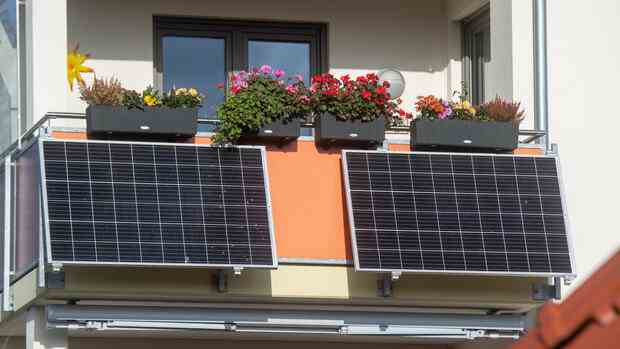Berlin A position paper by the Electrical Engineering Association (VDE) on balcony solar systems has caused a stir in the industry. Shortly after publication, the first enthusiastic comments came, for example from the eco-energy cooperative “Green Planet Energy”: This is a “real breakthrough” for photovoltaic systems, which are also advertised as balcony power plants or plug-in PV systems.
With reference to the position paper, companies are already advertising devices that comply with the new standards proposed by the VDE.
But consumer advocates warn: “I can only advise consumers to be careful with the changes that are emerging in plug-in PV. So far, these have only been suggestions by the VDE,” says Jörg Sutter, photovoltaics expert at the NRW consumer advice center. “We take a very critical view of manufacturers already advertising the planned changes. That’s premature.”
So was the euphoria in the industry premature? The VDE, responsible for the standardization of electrotechnical devices, wants to pave the way for balcony photovoltaics and therefore proposes removing various obstacles to balcony solar systems. In the future, balcony power plants with an output of up to 800 watts will be allowed to be connected to the home network. So far, there was an upper limit of 600 watts.
Conventional Schuko sockets should also be tolerated for connecting the devices to the domestic power supply. According to the position paper, the VDE no longer wants to insist on using so-called Wieland sockets. Wieland sockets have to be installed by professionals and therefore cost extra money.
Balcony power plant: VDE is in favor of simplifications for the balcony solar system
In the future, the VDE wants to allow operation using any type of electricity meter, i.e. even on meters that turn backwards when more electricity is being fed into the home network than is being consumed. In addition, there should be a further simplification in the form of a simplified registration. It should only be required by the Federal Network Agency, no longer by the local distribution network operator.
But it may be some time before these announcements become reality. “Laws and regulations still have to be changed before the changes actually apply. That can take months,” says consumer advocate Sutter. “In the worst case, the changes are implemented in slices, which leads to transitional phases with an unclear legal situation,” he adds.
Alexander Nollau from the VDE confirms Sutter’s assessment: “Of course, the proposals from the VDE position paper do not override the applicable rules, ordinances and laws. They only show what steps we think make sense.” Many things have not yet been clarified in terms of regulation. “We are currently in the process of coordinating with the Federal Network Agency and the Federal Ministry of Economics.”
According to Nollau, counting backwards is a particularly difficult issue. This question still requires the amendment of laws and ordinances. At the moment it is still the case that meters must have a reverse lockout if a balcony PV system is connected.
Balcony power plants are intended to help bring the energy transition to inner cities. Usually it is one or two photovoltaic modules that can be hung vertically on the balcony railing. The upper power limit of currently 600 watts is defined by the inverter, which is an integral part of the system.
Balcony solar system saves up to 160 euros per year
The systems work best when the balcony is south-facing and there is little to no shading. They usually cost between 500 and 1000 euros, including the inverter and connection material. According to HTW Berlin, a single module with an output of 300 watts installed vertically on a south-facing balcony produces almost 200 kilowatt hours of electricity per year.
A 600 watt balcony power plant should therefore supply around 400 kilowatt hours of electricity per year. At a price of 40 cents per kilowatt hour of electricity, the 600-watt power plant theoretically reduces the electricity bill by 160 euros per year.
The prerequisite for this, however, is that whenever the balcony power plant is producing electricity, electricity is also being consumed in the household in question. Excess electricity otherwise goes unused into the local grid. Theoretically, this can be prevented with a battery as a buffer storage, but the costs for this increase the price of a balcony power plant significantly.
In addition, tenants and apartment owners are well advised to have their plans for the installation of a balcony PV system approved by the landlord, the property management company or the homeowners’ association.
